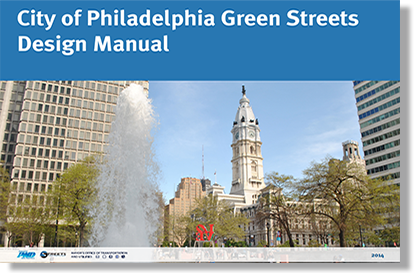Green Streets Program
A Green Street uses green stormwater infrastructure to capture and manage rain or melting snow (runoff) directly from the street. Green Streets allow runoff to soak into soil, filtering out pollutants like oil, and reduce the amount of stormwater making its way into Philadelphia’s combined sewer pipes, which reduces the combined sewer overflows that degrade our waterways.

Overview
In Philadelphia, streets and sidewalks account for 38% of the impervious cover within the combined sewer service area. This is by far the largest single category of public impervious cover in the city, making the Green Streets program a key component of the Green City, Clean Waters plan. Streets are engineered to take runoff and funnel it to our sewer system through inlets. By developing green stormwater infrastructure specifically designed for the street and right-of-way that captures runoff before it reaches the inlet, we have a unique and important chance to create standard, replicable designs that can be implemented throughout the city. Ultimately, the Green Streets program should result in setting a “green standard” for streets within the City. Check out information about our Green Streets Design Manual in the resources section below.
How Does a Green Street Work?
Green Street designs turn city streets into stormwater management systems while still maintaining their primary function as a transportation pathway for vehicles and pedestrians. Green Streets use various green stormwater infrastructure tools, including stormwater tree trenches, stormwater planters, stormwater bumpouts, and pervious pavement, to capture runoff directly from streets and sidewalks. Instead of entering our combined sewer system, runoff is absorbed by specially engineered systems that use soils, stones and plants that soak up water.
In addition, Green Streets can improve pedestrian and bicycle safety, improve air quality and help alleviate the Urban Heat Island effect by reducing air temperatures, and enhance the aesthetics of the right-of-way.
Green Street Partnerships
Philadelphia Water works closely with the Streets Department, Mayor's Office of Transportation and Utilities, Philadelphia City Planning Commission, PennDOT and other organizations on Green Street projects. Interagency collaboration is key to the successful implementation of green infrastructure citywide. PWD also provides technical assistance is to other City agencies undertaking renewal projects within the right-of-way in order to encourage designs to include green stormwater infrastructure elements.
Projects
There are over 200 Green Street projects constructed or in design in Philadelphia! Here are a few highlighted projects:
| Columbus Square | Queen Lane Bumpouts | West Mill Creek Tree Trench |
| Lancaster Avenue ReStore Corridor | Bureau of Laboratory Services | Waterview Tree Trench |
Green Streets Resources

Released in 2014, the Green Streets Design Manual sets a new standard for how Philadelphia will design and construct streets. It provides design standards and procedural guidance for developing Green Streets that manage stormwater runoff using a comprehensive planning approach. It includes finely-tuned design templates that are detailed enough to be informative to design professionals, yet flexible enough to be applied to a variety of urban street conditions.